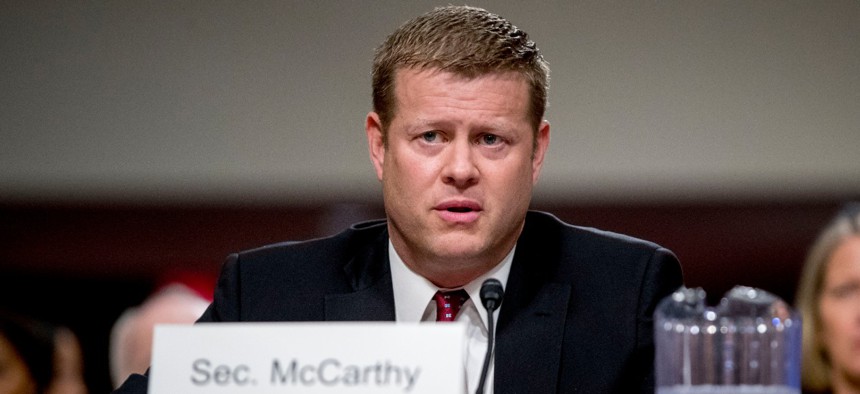
Ryan McCarthy, the nominee to the Secretary of the Army, speaks during his Senate Armed Services Committee confirmation hearing, Thursday, Sept. 12, 2019, in Washington. Andrew Harnik/AP
Viewpoint: We Really Need to Fix the Federal Budget Process
With the 2020 defense policy bill close to done, here are some ideas for next year.
SIMI VALLEY, California — What keeps Army Secretary Ryan McCarthy up at night? Things like not knowing, nearly one-quarter into the fiscal year, whether his service is going to be able to start new programs, or even keep civilian staff at work.
“The reality of it, I think, is just the challenges of getting things done in Washington,” McCarthy said at last weekend’s Reagan National Defense Forum. “We gotta be less partisan. We gotta work better together” to modernize the force. “There will be political challenges, there are differences of views, but we have to do better to work faster to get things done. The world’s incredibly complex and dangerous. We have to get these capabilities.”
Instead, forum attendees welcomed indications that Congress will soon pass the 2020 defense authorization bill, currently more than two months late; the White House signaled on Tuesday that President Trump will sign the bill that lawmakers in the House and Senate agreed to late last week. Attendees took this as a hopeful sign that appropriations bills — the ones that actually release the money — might soon follow, and thereby avoid a government shutdown that looms less than two weeks away.
“Such an achievement bodes well for eventually getting appropriations passed before the deadline on December 20,” Matt Vallone, director of research and analysis for Avascent, wrote on Tuesday.
The proposed 2020 NDAA would greenlight $738 billion for a host of military projects, including the creation of a U.S. Space Force, a new branch of the military within the Air Force. The bill also includes funds to purchase buy Lockheed Martin F-35 Joint Strike Fighters originally ordered by Turkey.
But while the Reagan Forum’s agenda largely focused on strategic competition with Russia and China, conversation often strayed back to Congress’ inability to pass a budget on time, and how it is hurting the military.
“I think we’re at that point of totally overhauling the federal budget process because it has not been working for a long time — basically a decade,” Todd Harrison, director of Defense Budget Analysis and the director of the Aerospace Security Project at the Center for Strategic and International Studies, said Monday. “It’s time for an update.”
Last year, Congress managed for the first time in a decade to pass an NDAA and defense appropriations bill before Oct. 1, the first day of the fiscal year. But lawmakers failed to extend that streak to two years, passing instead a series of stopgap spending measures that currently fund the government until Dec. 20. These continuing resolutions, offer spending for existing programs at the prior year’s level. No new projects can start while a CR is in place.
Complicating matters this year are the Democrat-led impeachment hearings that on Tuesday produced two articles of impeachment against Trump.
But the U.S. government is not in uncharted territory, Harrison said.
In October 1998, when the House had started its impeachment inquiry into then-President Clinton, it still passed the annual NDAA and appropriations bills, Harrison said.
“We had the defense authorization bill and the defense appropriations bill going through the pipeline and getting passed by Congress while we were in the middle of impeachment hearing and the impeachment trial in the Senate,” he said. “Congress has proven that they can walk and chew gum at the same time when it comes to impeachment and approps. This has happened before.”
Even without impeachment, the congressional process seems ripe for an overhaul. Some in the defense community have called for Congress to adopt two-year budget resolutions passed by Senate Budget Committee.
“We have an annual budget that we create every year and gets passed every year, which is just not an effective way to plan for the Department of Defense based on how long it takes to build the equipment and to train the people who use it,” Eric Fanning, CEO of the Aerospace Industries Association, said at Defense One’s Outlook 2020 event on Nov. 7.
The current budget, with seemingly annual continuing resolutions “is very disruptive for the Department of Defense and for industry to plan around that,” the former Army secretary said.
Harrison took it a step further, saying that two-year appropriations bills with a mid-point review for revisions and updates would make a difference. But it would have a downside as well. Pentagon officials want to move faster and innovate to keep pace with China and Russia, something that could be slowed down by two-year appropriation bills.
“We would just be making the budget process have a longer time, which is just going to slow down our ability to innovate,” Harrison said.
Another option could be aligning the U.S. government fiscal year to the calendar year. In 1974, lawmakers moved the start of the government fiscal year from July 1 to Oct. 1.
“They gave themselves three extra months,” Harrison said. “It worked for a long time. [Congress] actually started passing things closer to being on time [and] the delays got much shorter.”
Moving the fiscal year to Jan. 1, around the time the new Congress is seated, could give lawmakers three more months to work spending deals.
“The one time we did this in history, suggest that it will be effective for awhile in making the appropriations bills get passed closer to being on time,” Harrison said. “But then you have to remember, once you move the start of the fiscal year to Jan. 1, that’s it. You’ve run out of slack.”
NEXT STORY: Great Leaders Give Direction Not Directions







